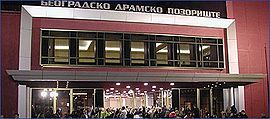- Crveni Krst (Belgrade)
-
Crveni Krst (English: Red Cross, Serbian Cyrillic: Црвени Крст, pronounced [tsrʋɛni kř̩ːst]) or colloquially just Krst is an urban neighborhood of Belgrade, the capital of Serbia. It is located in Belgrade's municipalities of Vračar (larger part) and Zvezdara.
Contents
Location
Crveni Krst is located in the east-central part of the municipality of Vračar and west part of the municipality of Zvezdara, around the small square of the same name. It borders the neighborhoods of Čubura on the west, Kalenić on the north-west, Đeram on the north, Lipov Lad on the north-east, Obilić Stadium area on the east and Lekino Brdo on the south.
History
The area of the modern Crveni Krst is in the eastern section of the Vračar field. In 1595 Ottoman grand vizier Sinan Pasha burned the relics of the major Serbian saint, Saint Sava, somewhere on the Vračar hill but after two centuries, the exact location was unknown. A majority of scholars agreed on a location on top of the hill, where the modern Cathedral of St Sava has recently been built. According to one version, reason why Serbian publisher Gligorije Vozarović (1790-1848) erected a wooden cross in the area was to mark what he thought was exact location. It is controversial since according to some historians, Saint Sava's relics weren't burned here, nor on the place where the Cathedral of Saint Sava was erected, but near the present-day Tašmajdan park[1]. Another version says that reasons why he erected what is to become Belgrade's first public monument were more benevolent, it represented symbol of victory and liberation foreseeing nation's complete independence from crumbling Turkish Empire[2].
The emerging settlement around it gradually became known as Vozarov Krst ("Vozarov[ić]'s Cross"). The Association of Saint Sava later replaced the wooden cross with a new, red one and it gave the present name to the neighborhood (Crveni Krst, Serbian for "Red Cross"). Still, the modern local community (mesna zajedinca) of the municipality of Vračar which comprises the neighbourhood is officially styled Vozarev Krst (Vozarov and Vozarev i.e. adjectives ending in -ov/-ev are variant spellings like English -ise/-ize), with a population of 12,736 in 2002 (excluding the Zvezdara part).
In addition to Cross, two important sacral buildings in the neighbourhood are Orthodox Church of the Holy Protection of the Virgin and Roman Catholic Church of St Anthony.
Church of the Holy Protection of the Virgin[3] was designed by famous architect Momir Korunović[4] and built in 1932-33. It is basilical in plan, with a choir loft, side galleries, and a four-storey bell-tower above the narthex. Designed in the Byzantine tradition, it also shows Romanesque elements, especially in the architecture of the bell-tower. It has two side chapels which are dedicated to St Anthony and St Petka respectively.
Church of St Anthony was designed by Jože Plečnik of Vienna Sezession and built in 1928-32. It is one of few round churches and the only example of Vienna Sezession in Belgrade (there are several other buildings in the style of other Art Nouveau movements), and it has the only leaning tower/bellfry in Belgrade, which is adjacent, but not actually attached, to the church building.
Characteristics
Today, Crveni Krst is essentially an eastern extension of the neighborhood of Čubura and some city maps mark the area as Čubura, but the local community which covers Vračar portion of the area of Crveni Krst rivals the local community which covers the area of Čubura in population (12,736 to 13,498 in 2002, respectively). In fact, taken as a whole (including its Zvezdara portion), area of Crveni Krst probably exceeds it.
The former small square, which comprises a minute park with the cross, was turned into the roundabout of the bus line 83 and trolleybus line 22L. Still, the square remains a crossroads of five streets: Mileševska, Vojvode Šupljikca, Branka Krsmanovića, Jovana Rajića and Žička. Interestingly, while just one bus line (83) goes through central part of the neighbourhood, five trolleybus lines do the same (lines 19, 21, 22, 22L and 29). On neighbourhood's southern fringe alongside South Boulevard, two additional bus lines are available (lines 46 and 55). On its northern fringe alongside King Alexander Boulevard, four tram lines are also available (lines 5, 6, 7 and 14) and future Line 1 of Belgrade light metro is planned to have its station there.
The main feature in Crveni Krst is the large building of the Belgrade Drama Theater, opened in 1948 and completely reconstructed in 2003. All major domestic and foreign banks have their branches in Crveni Krst. Neighborhood is also home to famous basketball club Radnički[5] which was national champion in 1973 and won national cup in 1976. Other important features are the complex of the Sports Center Vračar and Belgrade's Waterworks facilities.
References
- ^ Glas-Javnosti.rs - Saint Sava (Serbian)
- ^ BelgradeHeritage.com - Red Cross (English) (Serbian)
- ^ BelgradeHeritage.com - Church of the Holy Protection of the Virgin (English) (Serbian)
- ^ Momir Korunović (Serbian)
- ^ Radnički Beograd (English)
- Srpska porodična enciklopedija, Vol. VI (2006); Narodna knjiga and Politika NM; ISBN 86-331-2933-7 (Serbian)
Neighbourhoods of Belgrade's Vračar municipality Crveni Krst • Cvetni Trg • Čubura • Englezovac • Gradić Pejton • Grantovac • Kalenić • Krunski Venac • Neimar • Pašino Brdo (northern part) • Savinac • Slavija • Vračar (neighbourhood)Neighbourhoods of Belgrade's Zvezdara municipality Bulbuder • Crveni Krst • Cvetanova Ćuprija • Cvetkova Pijaca • Denkova Bašta • Đeram • Konjarnik • Konjarnik I • Konjarnik II • Konjarnik III • Lion • Lipov Lad • Mali Mokri Lug • Mirijevo • Mirijevo II • Mirijevo III • Mirijevo IV • Novo Mirijevo • Orlovsko Naselje • Padina • Rudo • Staro Mirijevo • Učiteljsko Naselje • Veliki Mokri Lug • Vukov Spomenik • Zeleno Brdo • Zvezdara (neighbourhood) • Zvezdara IICategories:- Neighborhoods of Belgrade
Wikimedia Foundation. 2010.

